MNG93003 - Employee Turnover Impact on Barclays Bank PLC Performance
VerifiedAdded on 2023/06/14
|52
|12920
|55
Report
AI Summary
This report investigates the impact of employee turnover on Barclays Bank PLC (Australian Branch) performance. It identifies the causes of turnover, including salary dissatisfaction, lack of career progression, and poor work-life balance, through questionnaires and interviews with 100 employees. The research reveals that employee turnover leads to decreased work output, reduced product quality, resource depletion, and service delivery interruptions. The report recommends strategies to reduce turnover, such as offering competitive salaries, providing career development opportunities, and recognizing employee contributions. The study's findings highlight the importance of addressing employee concerns to improve organizational performance. It is a MNG93003 Industry Research Project.

SOUTHERN CROSS UNIVERSITY
ASSIGNMENT COVER SHEET
Student Name: Mohit Suneja
Student ID No.: 22414081
Unit Name: Industry Research Project
Unit Code: MNG93003
Tutor’s name: Dr Chrys Gunasekara
Assignment No.: 3
Assignment Title: Final Report
Due date: 04/02/2018
Date submitted: 04/02/2018
Declaration:
I have read and understand the Rules Relating to Awards (Rule 3 Section 18 –
Academic Misconduct Including Plagiarism) as contained in the SCU Policy
Library. I understand the penalties that apply for plagiarism and agree to be bound
by these rules. The work I am submitting electronically is entirely my own work.
Signed: Mohit Suneja
Date: 04/02/2018
ASSIGNMENT COVER SHEET
Student Name: Mohit Suneja
Student ID No.: 22414081
Unit Name: Industry Research Project
Unit Code: MNG93003
Tutor’s name: Dr Chrys Gunasekara
Assignment No.: 3
Assignment Title: Final Report
Due date: 04/02/2018
Date submitted: 04/02/2018
Declaration:
I have read and understand the Rules Relating to Awards (Rule 3 Section 18 –
Academic Misconduct Including Plagiarism) as contained in the SCU Policy
Library. I understand the penalties that apply for plagiarism and agree to be bound
by these rules. The work I am submitting electronically is entirely my own work.
Signed: Mohit Suneja
Date: 04/02/2018
Paraphrase This Document
Need a fresh take? Get an instant paraphrase of this document with our AI Paraphraser

1
Barclays Bank PLC (Australian Branch)
performance from impact of employee
turnover
11,500
Barclays Bank PLC (Australian Branch)
performance from impact of employee
turnover
11,500
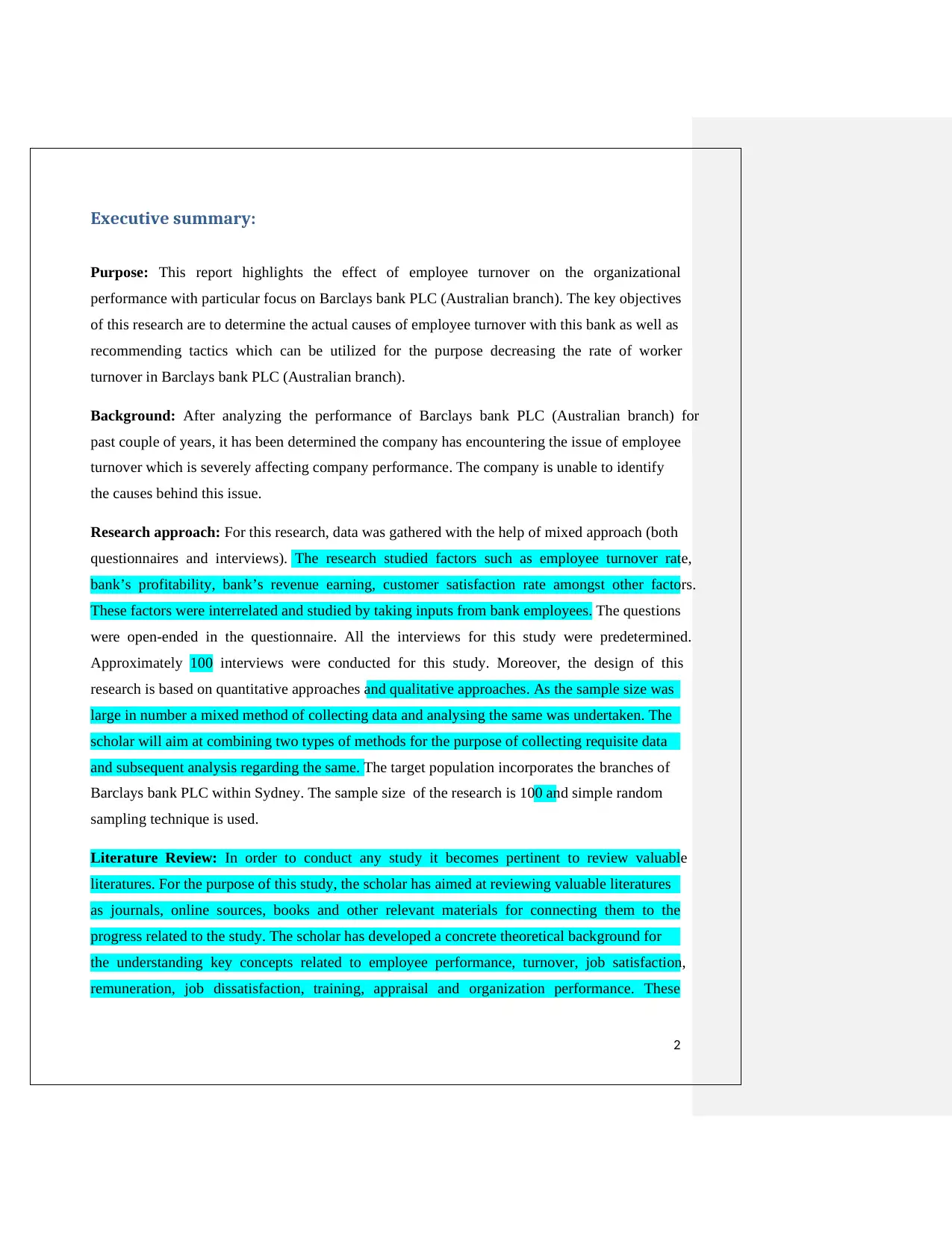
2
Executive summary:
Purpose: This report highlights the effect of employee turnover on the organizational
performance with particular focus on Barclays bank PLC (Australian branch). The key objectives
of this research are to determine the actual causes of employee turnover with this bank as well as
recommending tactics which can be utilized for the purpose decreasing the rate of worker
turnover in Barclays bank PLC (Australian branch).
Background: After analyzing the performance of Barclays bank PLC (Australian branch) for
past couple of years, it has been determined the company has encountering the issue of employee
turnover which is severely affecting company performance. The company is unable to identify
the causes behind this issue.
Research approach: For this research, data was gathered with the help of mixed approach (both
questionnaires and interviews). The research studied factors such as employee turnover rate,
bank’s profitability, bank’s revenue earning, customer satisfaction rate amongst other factors.
These factors were interrelated and studied by taking inputs from bank employees. The questions
were open-ended in the questionnaire. All the interviews for this study were predetermined.
Approximately 100 interviews were conducted for this study. Moreover, the design of this
research is based on quantitative approaches and qualitative approaches. As the sample size was
large in number a mixed method of collecting data and analysing the same was undertaken. The
scholar will aim at combining two types of methods for the purpose of collecting requisite data
and subsequent analysis regarding the same. The target population incorporates the branches of
Barclays bank PLC within Sydney. The sample size of the research is 100 and simple random
sampling technique is used.
Literature Review: In order to conduct any study it becomes pertinent to review valuable
literatures. For the purpose of this study, the scholar has aimed at reviewing valuable literatures
as journals, online sources, books and other relevant materials for connecting them to the
progress related to the study. The scholar has developed a concrete theoretical background for
the understanding key concepts related to employee performance, turnover, job satisfaction,
remuneration, job dissatisfaction, training, appraisal and organization performance. These
Executive summary:
Purpose: This report highlights the effect of employee turnover on the organizational
performance with particular focus on Barclays bank PLC (Australian branch). The key objectives
of this research are to determine the actual causes of employee turnover with this bank as well as
recommending tactics which can be utilized for the purpose decreasing the rate of worker
turnover in Barclays bank PLC (Australian branch).
Background: After analyzing the performance of Barclays bank PLC (Australian branch) for
past couple of years, it has been determined the company has encountering the issue of employee
turnover which is severely affecting company performance. The company is unable to identify
the causes behind this issue.
Research approach: For this research, data was gathered with the help of mixed approach (both
questionnaires and interviews). The research studied factors such as employee turnover rate,
bank’s profitability, bank’s revenue earning, customer satisfaction rate amongst other factors.
These factors were interrelated and studied by taking inputs from bank employees. The questions
were open-ended in the questionnaire. All the interviews for this study were predetermined.
Approximately 100 interviews were conducted for this study. Moreover, the design of this
research is based on quantitative approaches and qualitative approaches. As the sample size was
large in number a mixed method of collecting data and analysing the same was undertaken. The
scholar will aim at combining two types of methods for the purpose of collecting requisite data
and subsequent analysis regarding the same. The target population incorporates the branches of
Barclays bank PLC within Sydney. The sample size of the research is 100 and simple random
sampling technique is used.
Literature Review: In order to conduct any study it becomes pertinent to review valuable
literatures. For the purpose of this study, the scholar has aimed at reviewing valuable literatures
as journals, online sources, books and other relevant materials for connecting them to the
progress related to the study. The scholar has developed a concrete theoretical background for
the understanding key concepts related to employee performance, turnover, job satisfaction,
remuneration, job dissatisfaction, training, appraisal and organization performance. These
⊘ This is a preview!⊘
Do you want full access?
Subscribe today to unlock all pages.

Trusted by 1+ million students worldwide
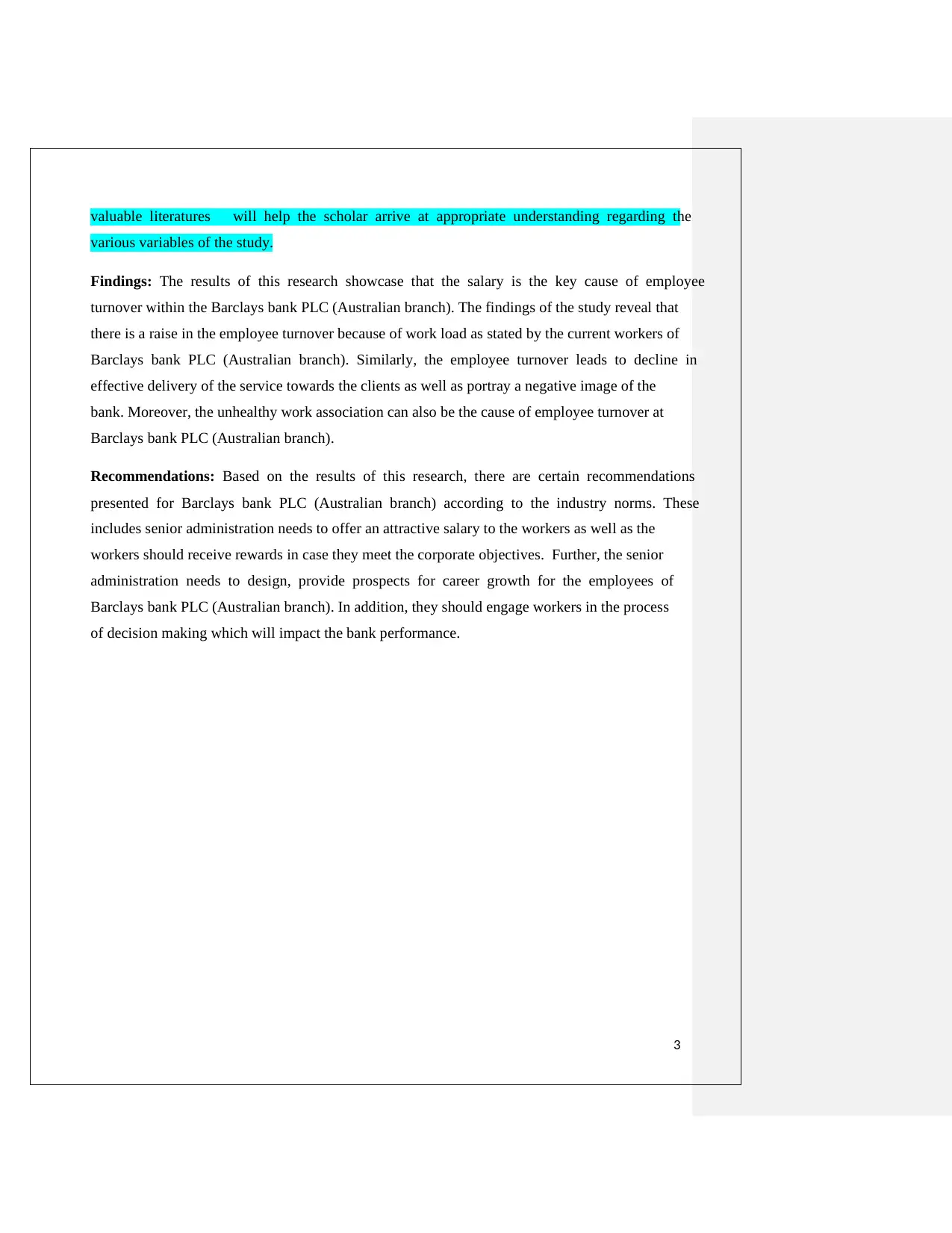
3
valuable literatures will help the scholar arrive at appropriate understanding regarding the
various variables of the study.
Findings: The results of this research showcase that the salary is the key cause of employee
turnover within the Barclays bank PLC (Australian branch). The findings of the study reveal that
there is a raise in the employee turnover because of work load as stated by the current workers of
Barclays bank PLC (Australian branch). Similarly, the employee turnover leads to decline in
effective delivery of the service towards the clients as well as portray a negative image of the
bank. Moreover, the unhealthy work association can also be the cause of employee turnover at
Barclays bank PLC (Australian branch).
Recommendations: Based on the results of this research, there are certain recommendations
presented for Barclays bank PLC (Australian branch) according to the industry norms. These
includes senior administration needs to offer an attractive salary to the workers as well as the
workers should receive rewards in case they meet the corporate objectives. Further, the senior
administration needs to design, provide prospects for career growth for the employees of
Barclays bank PLC (Australian branch). In addition, they should engage workers in the process
of decision making which will impact the bank performance.
valuable literatures will help the scholar arrive at appropriate understanding regarding the
various variables of the study.
Findings: The results of this research showcase that the salary is the key cause of employee
turnover within the Barclays bank PLC (Australian branch). The findings of the study reveal that
there is a raise in the employee turnover because of work load as stated by the current workers of
Barclays bank PLC (Australian branch). Similarly, the employee turnover leads to decline in
effective delivery of the service towards the clients as well as portray a negative image of the
bank. Moreover, the unhealthy work association can also be the cause of employee turnover at
Barclays bank PLC (Australian branch).
Recommendations: Based on the results of this research, there are certain recommendations
presented for Barclays bank PLC (Australian branch) according to the industry norms. These
includes senior administration needs to offer an attractive salary to the workers as well as the
workers should receive rewards in case they meet the corporate objectives. Further, the senior
administration needs to design, provide prospects for career growth for the employees of
Barclays bank PLC (Australian branch). In addition, they should engage workers in the process
of decision making which will impact the bank performance.
Paraphrase This Document
Need a fresh take? Get an instant paraphrase of this document with our AI Paraphraser
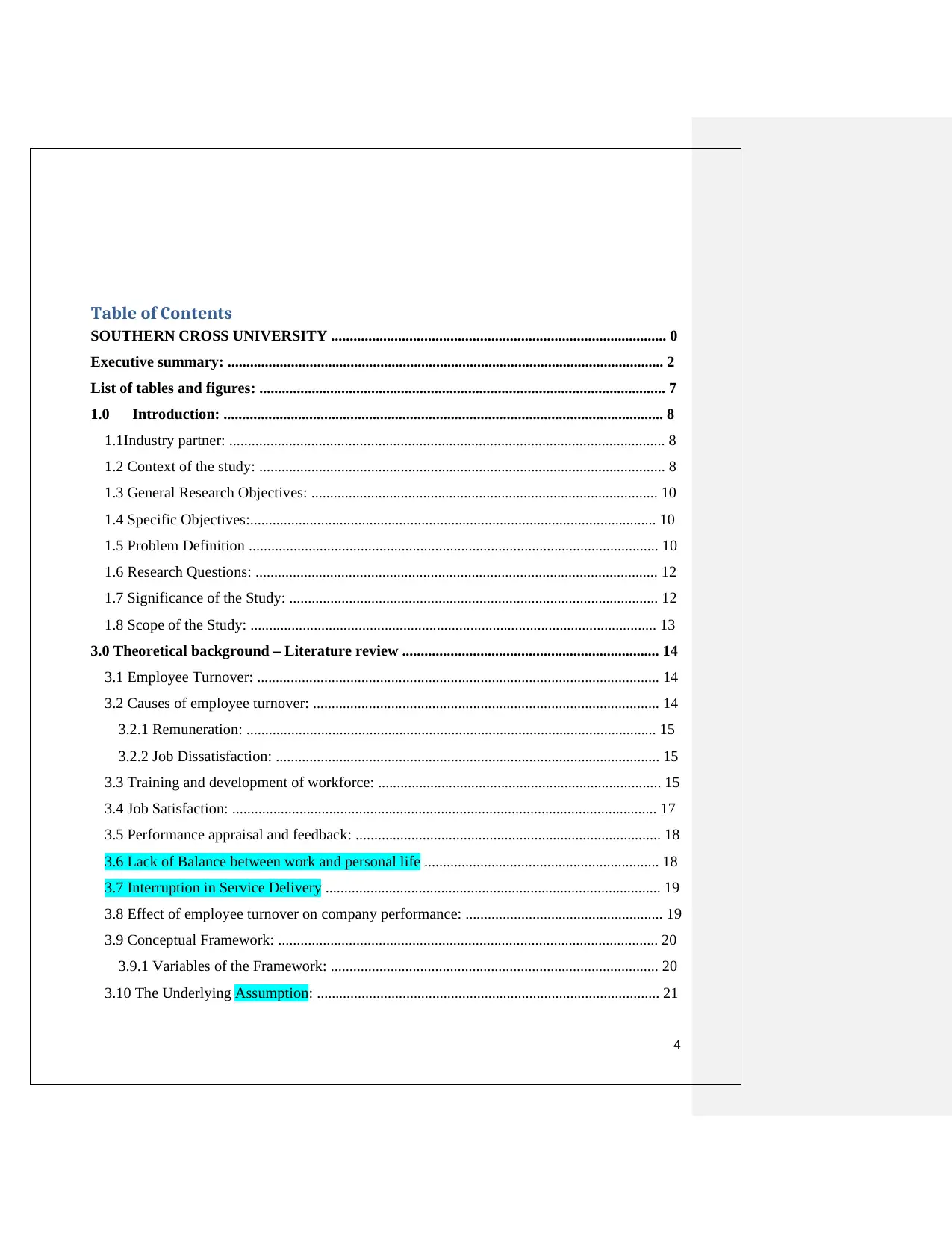
4
Table of Contents
SOUTHERN CROSS UNIVERSITY .......................................................................................... 0
Executive summary: ..................................................................................................................... 2
List of tables and figures: ............................................................................................................. 7
1.0 Introduction: ...................................................................................................................... 8
1.1Industry partner: ..................................................................................................................... 8
1.2 Context of the study: ............................................................................................................. 8
1.3 General Research Objectives: ............................................................................................. 10
1.4 Specific Objectives:............................................................................................................. 10
1.5 Problem Definition .............................................................................................................. 10
1.6 Research Questions: ............................................................................................................ 12
1.7 Significance of the Study: ................................................................................................... 12
1.8 Scope of the Study: ............................................................................................................. 13
3.0 Theoretical background – Literature review ..................................................................... 14
3.1 Employee Turnover: ............................................................................................................ 14
3.2 Causes of employee turnover: ............................................................................................. 14
3.2.1 Remuneration: .............................................................................................................. 15
3.2.2 Job Dissatisfaction: ....................................................................................................... 15
3.3 Training and development of workforce: ............................................................................ 15
3.4 Job Satisfaction: .................................................................................................................. 17
3.5 Performance appraisal and feedback: .................................................................................. 18
3.6 Lack of Balance between work and personal life ............................................................... 18
3.7 Interruption in Service Delivery .......................................................................................... 19
3.8 Effect of employee turnover on company performance: ..................................................... 19
3.9 Conceptual Framework: ...................................................................................................... 20
3.9.1 Variables of the Framework: ........................................................................................ 20
3.10 The Underlying Assumption: ............................................................................................ 21
Table of Contents
SOUTHERN CROSS UNIVERSITY .......................................................................................... 0
Executive summary: ..................................................................................................................... 2
List of tables and figures: ............................................................................................................. 7
1.0 Introduction: ...................................................................................................................... 8
1.1Industry partner: ..................................................................................................................... 8
1.2 Context of the study: ............................................................................................................. 8
1.3 General Research Objectives: ............................................................................................. 10
1.4 Specific Objectives:............................................................................................................. 10
1.5 Problem Definition .............................................................................................................. 10
1.6 Research Questions: ............................................................................................................ 12
1.7 Significance of the Study: ................................................................................................... 12
1.8 Scope of the Study: ............................................................................................................. 13
3.0 Theoretical background – Literature review ..................................................................... 14
3.1 Employee Turnover: ............................................................................................................ 14
3.2 Causes of employee turnover: ............................................................................................. 14
3.2.1 Remuneration: .............................................................................................................. 15
3.2.2 Job Dissatisfaction: ....................................................................................................... 15
3.3 Training and development of workforce: ............................................................................ 15
3.4 Job Satisfaction: .................................................................................................................. 17
3.5 Performance appraisal and feedback: .................................................................................. 18
3.6 Lack of Balance between work and personal life ............................................................... 18
3.7 Interruption in Service Delivery .......................................................................................... 19
3.8 Effect of employee turnover on company performance: ..................................................... 19
3.9 Conceptual Framework: ...................................................................................................... 20
3.9.1 Variables of the Framework: ........................................................................................ 20
3.10 The Underlying Assumption: ............................................................................................ 21

5
3.11 Hypotheses: ....................................................................................................................... 21
4.0 Methodology: ......................................................................................................................... 22
4.1 Research design: .................................................................................................................. 22
4.2 Selection of the study area: ................................................................................................. 22
4.3 Target population: ............................................................................................................... 22
4.4 Sample size:......................................................................................................................... 22
4.5 Sampling technique: ............................................................................................................ 23
4.6 Simple random sampling:.................................................................................................... 23
4.7 Data gathering methods:...................................................................................................... 23
4.7.1Interview: ....................................................................................................................... 23
4.7.2Questionnaire: ................................................................................................................ 24
Questionnaire 1: Research questionnaire for Barclays Bank PLC (Australian Branch): ... 24
PART A: General information: ................................................................................................. 24
PART B: Questionnaire to respondents: ................................................................................... 25
Question 2: Interview questions for Barclays Bank PLC (Australian Branch): .................. 29
PART A: GENERAL INFORMATION: .................................................................................. 29
SECTION B: INTERVIEW QUESTIONS: .............................................................................. 30
4.8 Types of Data ...................................................................................................................... 30
(a) Secondary Data: ............................................................................................................... 30
(b) Primary Data: ................................................................................................................... 30
4.9 Documentation Method: ...................................................................................................... 31
4.10 Data Presentation: ............................................................................................................. 31
4.11 Questionnaire: ................................................................................................................... 31
4.12 Interview questions: .......................................................................................................... 31
5.0 Research Findings (Results): ............................................................................................... 33
5.1 Objective 1: The causes of employee turnover in Barclays bank PLC (Australian branch):
................................................................................................................................................... 33
Salary satisfaction: ................................................................................................................. 33
Prospects for Career progression (Training): ........................................................................ 34
Employee Involvement in Decision Making: ........................................................................ 34
Input not valued: .................................................................................................................... 35
3.11 Hypotheses: ....................................................................................................................... 21
4.0 Methodology: ......................................................................................................................... 22
4.1 Research design: .................................................................................................................. 22
4.2 Selection of the study area: ................................................................................................. 22
4.3 Target population: ............................................................................................................... 22
4.4 Sample size:......................................................................................................................... 22
4.5 Sampling technique: ............................................................................................................ 23
4.6 Simple random sampling:.................................................................................................... 23
4.7 Data gathering methods:...................................................................................................... 23
4.7.1Interview: ....................................................................................................................... 23
4.7.2Questionnaire: ................................................................................................................ 24
Questionnaire 1: Research questionnaire for Barclays Bank PLC (Australian Branch): ... 24
PART A: General information: ................................................................................................. 24
PART B: Questionnaire to respondents: ................................................................................... 25
Question 2: Interview questions for Barclays Bank PLC (Australian Branch): .................. 29
PART A: GENERAL INFORMATION: .................................................................................. 29
SECTION B: INTERVIEW QUESTIONS: .............................................................................. 30
4.8 Types of Data ...................................................................................................................... 30
(a) Secondary Data: ............................................................................................................... 30
(b) Primary Data: ................................................................................................................... 30
4.9 Documentation Method: ...................................................................................................... 31
4.10 Data Presentation: ............................................................................................................. 31
4.11 Questionnaire: ................................................................................................................... 31
4.12 Interview questions: .......................................................................................................... 31
5.0 Research Findings (Results): ............................................................................................... 33
5.1 Objective 1: The causes of employee turnover in Barclays bank PLC (Australian branch):
................................................................................................................................................... 33
Salary satisfaction: ................................................................................................................. 33
Prospects for Career progression (Training): ........................................................................ 34
Employee Involvement in Decision Making: ........................................................................ 34
Input not valued: .................................................................................................................... 35
⊘ This is a preview!⊘
Do you want full access?
Subscribe today to unlock all pages.

Trusted by 1+ million students worldwide

6
Lack of balance between work and personal life: ................................................................. 36
5.2 Objective 2: Performance assessment: ................................................................................ 37
Performance assessment: ....................................................................................................... 37
5.3 Objective 3: The effect of worker turnover on company performance in Barclays bank PLC
(Australian branch):................................................................................................................... 38
Decline in Work Output: ....................................................................................................... 38
Decline in the product quality being manufactured: ............................................................. 39
Depletion of resources: .......................................................................................................... 40
Workers not fulfilling commitments: .................................................................................... 40
Interruption of Service Delivery: ........................................................................................... 41
Loss of Customers: ................................................................................................................ 42
Raising load of work for every worker: ................................................................................. 42
5.4 Objective 4: Suggest tactics which can be utilized for decreasing high scale of worker
turnover in Barclays bank PLC (Australian branch): ................................................................ 43
Worker appreciation for target accomplishment: .................................................................. 43
Workers need to be well paid: ............................................................................................... 44
Staffs work association: ......................................................................................................... 44
6.0 Discussion: ............................................................................................................................. 45
6.1 Primary causes for workers to quit their job: ...................................................................... 45
6.2 Range of salary: ................................................................................................................... 45
6.3 Absence of appreciation: ..................................................................................................... 45
6.4 Shortage of Training and Career progression: .................................................................... 46
6.5 Absence of balance between personal and professional life: .............................................. 46
6.6 Actions which the administration need to take for decreasing employee turnover ............ 46
7.0 Conclusion: ............................................................................................................................ 47
7.1 Recommendations: .............................................................................................................. 47
7.2 Limitation of the Study: ...................................................................................................... 48
References:................................................................................................................................... 49
Lack of balance between work and personal life: ................................................................. 36
5.2 Objective 2: Performance assessment: ................................................................................ 37
Performance assessment: ....................................................................................................... 37
5.3 Objective 3: The effect of worker turnover on company performance in Barclays bank PLC
(Australian branch):................................................................................................................... 38
Decline in Work Output: ....................................................................................................... 38
Decline in the product quality being manufactured: ............................................................. 39
Depletion of resources: .......................................................................................................... 40
Workers not fulfilling commitments: .................................................................................... 40
Interruption of Service Delivery: ........................................................................................... 41
Loss of Customers: ................................................................................................................ 42
Raising load of work for every worker: ................................................................................. 42
5.4 Objective 4: Suggest tactics which can be utilized for decreasing high scale of worker
turnover in Barclays bank PLC (Australian branch): ................................................................ 43
Worker appreciation for target accomplishment: .................................................................. 43
Workers need to be well paid: ............................................................................................... 44
Staffs work association: ......................................................................................................... 44
6.0 Discussion: ............................................................................................................................. 45
6.1 Primary causes for workers to quit their job: ...................................................................... 45
6.2 Range of salary: ................................................................................................................... 45
6.3 Absence of appreciation: ..................................................................................................... 45
6.4 Shortage of Training and Career progression: .................................................................... 46
6.5 Absence of balance between personal and professional life: .............................................. 46
6.6 Actions which the administration need to take for decreasing employee turnover ............ 46
7.0 Conclusion: ............................................................................................................................ 47
7.1 Recommendations: .............................................................................................................. 47
7.2 Limitation of the Study: ...................................................................................................... 48
References:................................................................................................................................... 49
Paraphrase This Document
Need a fresh take? Get an instant paraphrase of this document with our AI Paraphraser
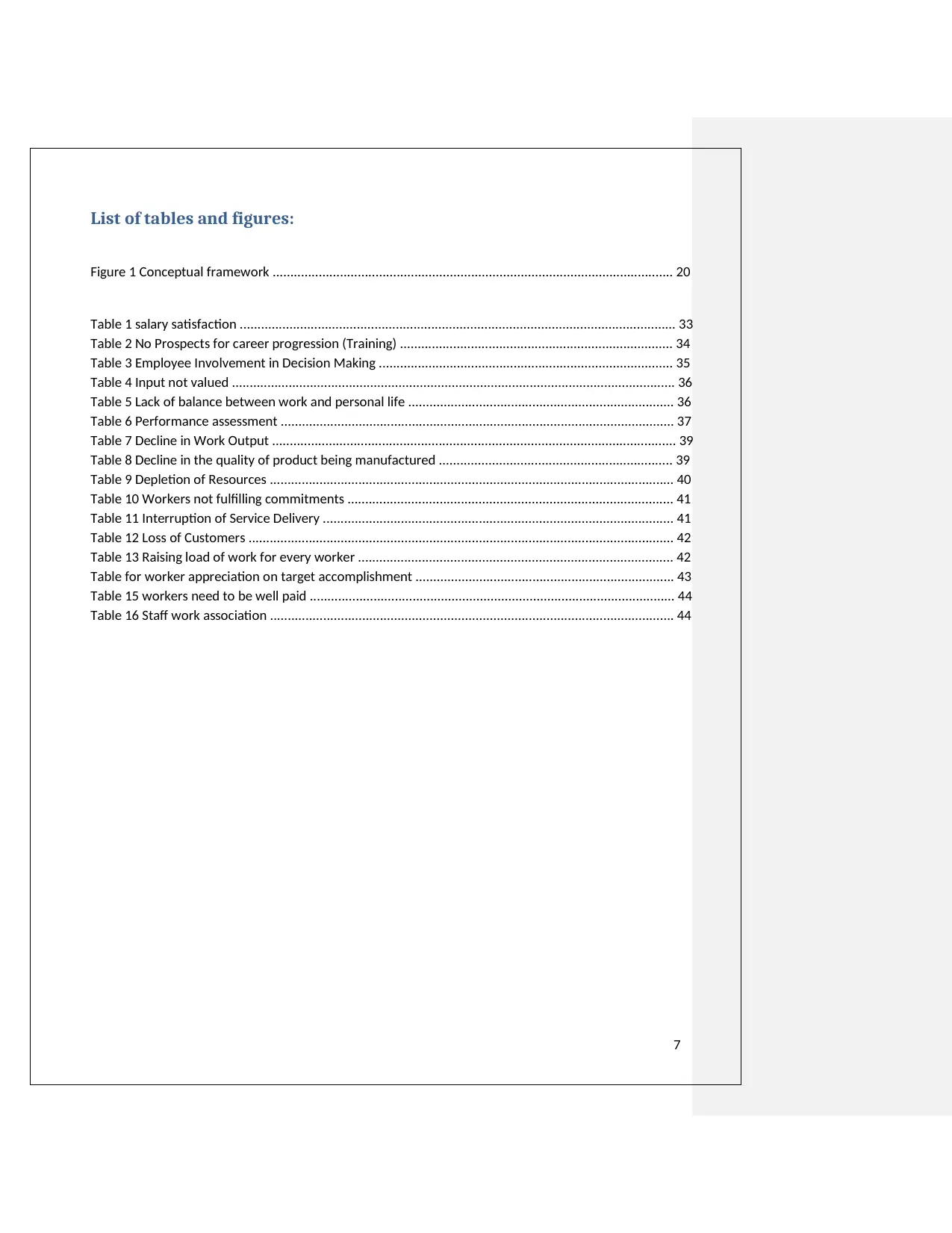
7
List of tables and figures:
Figure 1 Conceptual framework ................................................................................................................. 20
Table 1 salary satisfaction ........................................................................................................................... 33
Table 2 No Prospects for career progression (Training) ............................................................................. 34
Table 3 Employee Involvement in Decision Making ................................................................................... 35
Table 4 Input not valued ............................................................................................................................. 36
Table 5 Lack of balance between work and personal life ........................................................................... 36
Table 6 Performance assessment ............................................................................................................... 37
Table 7 Decline in Work Output .................................................................................................................. 39
Table 8 Decline in the quality of product being manufactured .................................................................. 39
Table 9 Depletion of Resources .................................................................................................................. 40
Table 10 Workers not fulfilling commitments ............................................................................................ 41
Table 11 Interruption of Service Delivery ................................................................................................... 41
Table 12 Loss of Customers ........................................................................................................................ 42
Table 13 Raising load of work for every worker ......................................................................................... 42
Table for worker appreciation on target accomplishment ......................................................................... 43
Table 15 workers need to be well paid ....................................................................................................... 44
Table 16 Staff work association .................................................................................................................. 44
List of tables and figures:
Figure 1 Conceptual framework ................................................................................................................. 20
Table 1 salary satisfaction ........................................................................................................................... 33
Table 2 No Prospects for career progression (Training) ............................................................................. 34
Table 3 Employee Involvement in Decision Making ................................................................................... 35
Table 4 Input not valued ............................................................................................................................. 36
Table 5 Lack of balance between work and personal life ........................................................................... 36
Table 6 Performance assessment ............................................................................................................... 37
Table 7 Decline in Work Output .................................................................................................................. 39
Table 8 Decline in the quality of product being manufactured .................................................................. 39
Table 9 Depletion of Resources .................................................................................................................. 40
Table 10 Workers not fulfilling commitments ............................................................................................ 41
Table 11 Interruption of Service Delivery ................................................................................................... 41
Table 12 Loss of Customers ........................................................................................................................ 42
Table 13 Raising load of work for every worker ......................................................................................... 42
Table for worker appreciation on target accomplishment ......................................................................... 43
Table 15 workers need to be well paid ....................................................................................................... 44
Table 16 Staff work association .................................................................................................................. 44
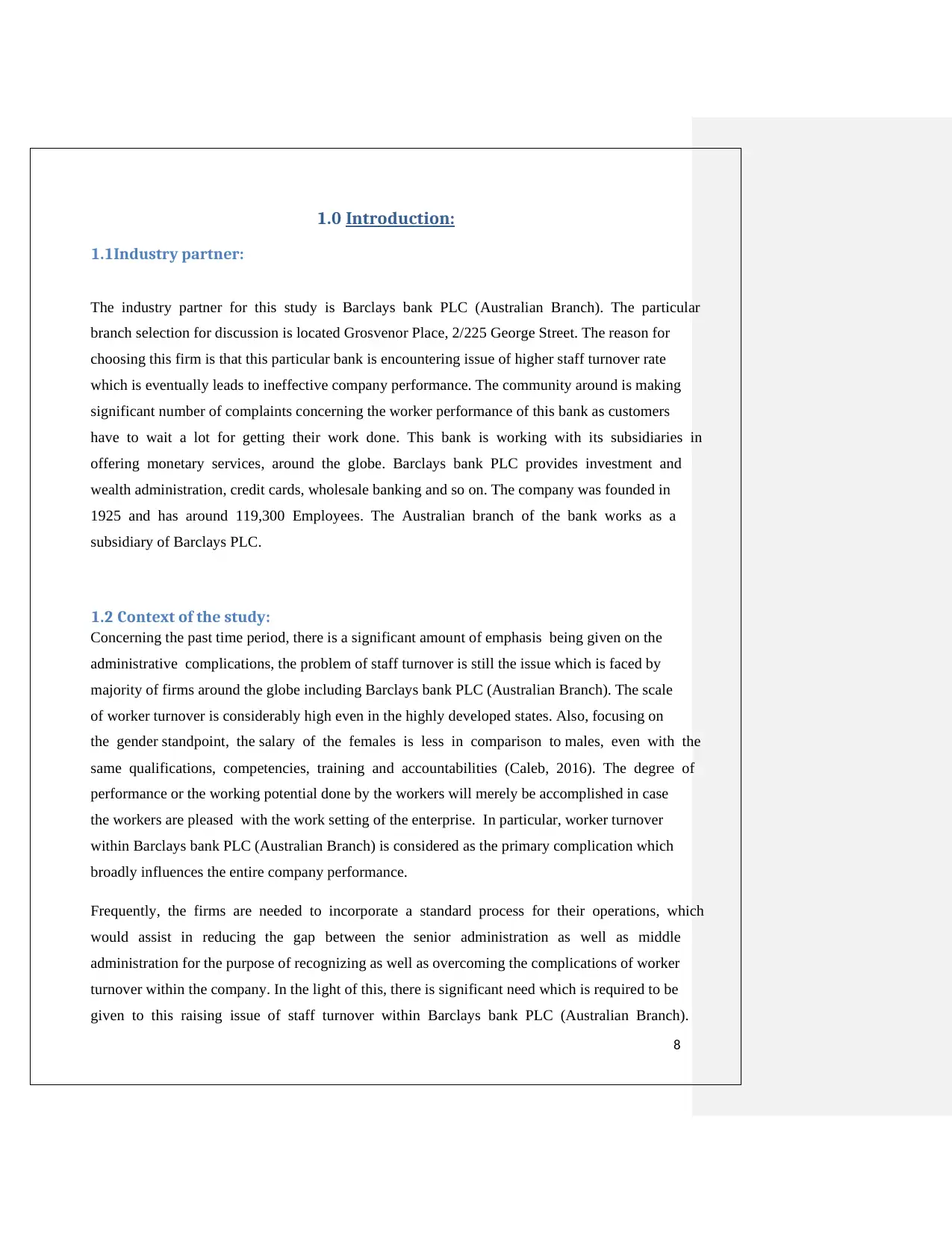
8
1.0 Introduction:
1.1Industry partner:
The industry partner for this study is Barclays bank PLC (Australian Branch). The particular
branch selection for discussion is located Grosvenor Place, 2/225 George Street. The reason for
choosing this firm is that this particular bank is encountering issue of higher staff turnover rate
which is eventually leads to ineffective company performance. The community around is making
significant number of complaints concerning the worker performance of this bank as customers
have to wait a lot for getting their work done. This bank is working with its subsidiaries in
offering monetary services, around the globe. Barclays bank PLC provides investment and
wealth administration, credit cards, wholesale banking and so on. The company was founded in
1925 and has around 119,300 Employees. The Australian branch of the bank works as a
subsidiary of Barclays PLC.
1.2 Context of the study:
Concerning the past time period, there is a significant amount of emphasis being given on the
administrative complications, the problem of staff turnover is still the issue which is faced by
majority of firms around the globe including Barclays bank PLC (Australian Branch). The scale
of worker turnover is considerably high even in the highly developed states. Also, focusing on
the gender standpoint, the salary of the females is less in comparison to males, even with the
same qualifications, competencies, training and accountabilities (Caleb, 2016). The degree of
performance or the working potential done by the workers will merely be accomplished in case
the workers are pleased with the work setting of the enterprise. In particular, worker turnover
within Barclays bank PLC (Australian Branch) is considered as the primary complication which
broadly influences the entire company performance.
Frequently, the firms are needed to incorporate a standard process for their operations, which
would assist in reducing the gap between the senior administration as well as middle
administration for the purpose of recognizing as well as overcoming the complications of worker
turnover within the company. In the light of this, there is significant need which is required to be
given to this raising issue of staff turnover within Barclays bank PLC (Australian Branch).
1.0 Introduction:
1.1Industry partner:
The industry partner for this study is Barclays bank PLC (Australian Branch). The particular
branch selection for discussion is located Grosvenor Place, 2/225 George Street. The reason for
choosing this firm is that this particular bank is encountering issue of higher staff turnover rate
which is eventually leads to ineffective company performance. The community around is making
significant number of complaints concerning the worker performance of this bank as customers
have to wait a lot for getting their work done. This bank is working with its subsidiaries in
offering monetary services, around the globe. Barclays bank PLC provides investment and
wealth administration, credit cards, wholesale banking and so on. The company was founded in
1925 and has around 119,300 Employees. The Australian branch of the bank works as a
subsidiary of Barclays PLC.
1.2 Context of the study:
Concerning the past time period, there is a significant amount of emphasis being given on the
administrative complications, the problem of staff turnover is still the issue which is faced by
majority of firms around the globe including Barclays bank PLC (Australian Branch). The scale
of worker turnover is considerably high even in the highly developed states. Also, focusing on
the gender standpoint, the salary of the females is less in comparison to males, even with the
same qualifications, competencies, training and accountabilities (Caleb, 2016). The degree of
performance or the working potential done by the workers will merely be accomplished in case
the workers are pleased with the work setting of the enterprise. In particular, worker turnover
within Barclays bank PLC (Australian Branch) is considered as the primary complication which
broadly influences the entire company performance.
Frequently, the firms are needed to incorporate a standard process for their operations, which
would assist in reducing the gap between the senior administration as well as middle
administration for the purpose of recognizing as well as overcoming the complications of worker
turnover within the company. In the light of this, there is significant need which is required to be
given to this raising issue of staff turnover within Barclays bank PLC (Australian Branch).
⊘ This is a preview!⊘
Do you want full access?
Subscribe today to unlock all pages.

Trusted by 1+ million students worldwide
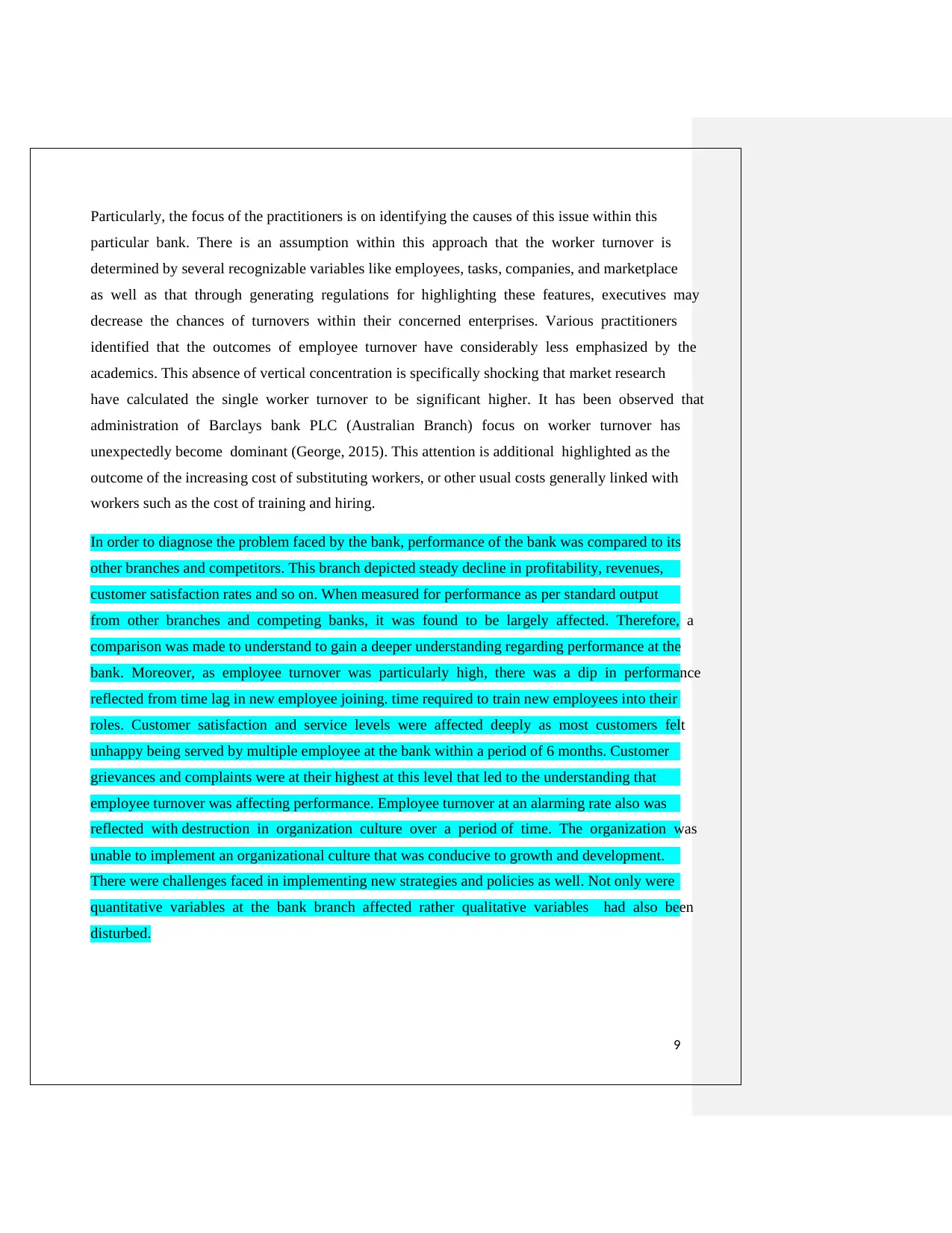
9
Particularly, the focus of the practitioners is on identifying the causes of this issue within this
particular bank. There is an assumption within this approach that the worker turnover is
determined by several recognizable variables like employees, tasks, companies, and marketplace
as well as that through generating regulations for highlighting these features, executives may
decrease the chances of turnovers within their concerned enterprises. Various practitioners
identified that the outcomes of employee turnover have considerably less emphasized by the
academics. This absence of vertical concentration is specifically shocking that market research
have calculated the single worker turnover to be significant higher. It has been observed that
administration of Barclays bank PLC (Australian Branch) focus on worker turnover has
unexpectedly become dominant (George, 2015). This attention is additional highlighted as the
outcome of the increasing cost of substituting workers, or other usual costs generally linked with
workers such as the cost of training and hiring.
In order to diagnose the problem faced by the bank, performance of the bank was compared to its
other branches and competitors. This branch depicted steady decline in profitability, revenues,
customer satisfaction rates and so on. When measured for performance as per standard output
from other branches and competing banks, it was found to be largely affected. Therefore, a
comparison was made to understand to gain a deeper understanding regarding performance at the
bank. Moreover, as employee turnover was particularly high, there was a dip in performance
reflected from time lag in new employee joining. time required to train new employees into their
roles. Customer satisfaction and service levels were affected deeply as most customers felt
unhappy being served by multiple employee at the bank within a period of 6 months. Customer
grievances and complaints were at their highest at this level that led to the understanding that
employee turnover was affecting performance. Employee turnover at an alarming rate also was
reflected with destruction in organization culture over a period of time. The organization was
unable to implement an organizational culture that was conducive to growth and development.
There were challenges faced in implementing new strategies and policies as well. Not only were
quantitative variables at the bank branch affected rather qualitative variables had also been
disturbed.
Particularly, the focus of the practitioners is on identifying the causes of this issue within this
particular bank. There is an assumption within this approach that the worker turnover is
determined by several recognizable variables like employees, tasks, companies, and marketplace
as well as that through generating regulations for highlighting these features, executives may
decrease the chances of turnovers within their concerned enterprises. Various practitioners
identified that the outcomes of employee turnover have considerably less emphasized by the
academics. This absence of vertical concentration is specifically shocking that market research
have calculated the single worker turnover to be significant higher. It has been observed that
administration of Barclays bank PLC (Australian Branch) focus on worker turnover has
unexpectedly become dominant (George, 2015). This attention is additional highlighted as the
outcome of the increasing cost of substituting workers, or other usual costs generally linked with
workers such as the cost of training and hiring.
In order to diagnose the problem faced by the bank, performance of the bank was compared to its
other branches and competitors. This branch depicted steady decline in profitability, revenues,
customer satisfaction rates and so on. When measured for performance as per standard output
from other branches and competing banks, it was found to be largely affected. Therefore, a
comparison was made to understand to gain a deeper understanding regarding performance at the
bank. Moreover, as employee turnover was particularly high, there was a dip in performance
reflected from time lag in new employee joining. time required to train new employees into their
roles. Customer satisfaction and service levels were affected deeply as most customers felt
unhappy being served by multiple employee at the bank within a period of 6 months. Customer
grievances and complaints were at their highest at this level that led to the understanding that
employee turnover was affecting performance. Employee turnover at an alarming rate also was
reflected with destruction in organization culture over a period of time. The organization was
unable to implement an organizational culture that was conducive to growth and development.
There were challenges faced in implementing new strategies and policies as well. Not only were
quantitative variables at the bank branch affected rather qualitative variables had also been
disturbed.
Paraphrase This Document
Need a fresh take? Get an instant paraphrase of this document with our AI Paraphraser
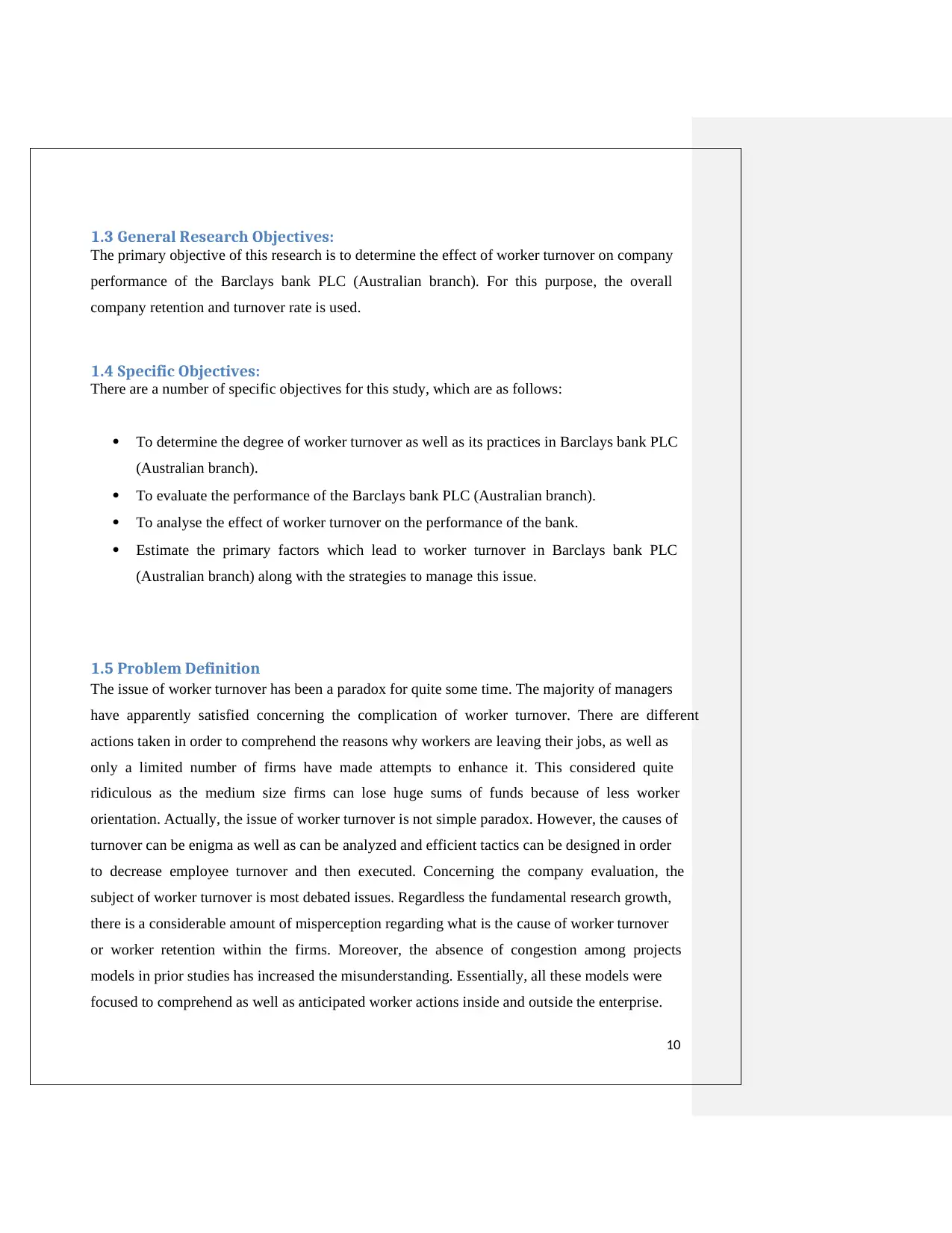
10
1.3 General Research Objectives:
The primary objective of this research is to determine the effect of worker turnover on company
performance of the Barclays bank PLC (Australian branch). For this purpose, the overall
company retention and turnover rate is used.
1.4 Specific Objectives:
There are a number of specific objectives for this study, which are as follows:
To determine the degree of worker turnover as well as its practices in Barclays bank PLC
(Australian branch).
To evaluate the performance of the Barclays bank PLC (Australian branch).
To analyse the effect of worker turnover on the performance of the bank.
Estimate the primary factors which lead to worker turnover in Barclays bank PLC
(Australian branch) along with the strategies to manage this issue.
1.5 Problem Definition
The issue of worker turnover has been a paradox for quite some time. The majority of managers
have apparently satisfied concerning the complication of worker turnover. There are different
actions taken in order to comprehend the reasons why workers are leaving their jobs, as well as
only a limited number of firms have made attempts to enhance it. This considered quite
ridiculous as the medium size firms can lose huge sums of funds because of less worker
orientation. Actually, the issue of worker turnover is not simple paradox. However, the causes of
turnover can be enigma as well as can be analyzed and efficient tactics can be designed in order
to decrease employee turnover and then executed. Concerning the company evaluation, the
subject of worker turnover is most debated issues. Regardless the fundamental research growth,
there is a considerable amount of misperception regarding what is the cause of worker turnover
or worker retention within the firms. Moreover, the absence of congestion among projects
models in prior studies has increased the misunderstanding. Essentially, all these models were
focused to comprehend as well as anticipated worker actions inside and outside the enterprise.
1.3 General Research Objectives:
The primary objective of this research is to determine the effect of worker turnover on company
performance of the Barclays bank PLC (Australian branch). For this purpose, the overall
company retention and turnover rate is used.
1.4 Specific Objectives:
There are a number of specific objectives for this study, which are as follows:
To determine the degree of worker turnover as well as its practices in Barclays bank PLC
(Australian branch).
To evaluate the performance of the Barclays bank PLC (Australian branch).
To analyse the effect of worker turnover on the performance of the bank.
Estimate the primary factors which lead to worker turnover in Barclays bank PLC
(Australian branch) along with the strategies to manage this issue.
1.5 Problem Definition
The issue of worker turnover has been a paradox for quite some time. The majority of managers
have apparently satisfied concerning the complication of worker turnover. There are different
actions taken in order to comprehend the reasons why workers are leaving their jobs, as well as
only a limited number of firms have made attempts to enhance it. This considered quite
ridiculous as the medium size firms can lose huge sums of funds because of less worker
orientation. Actually, the issue of worker turnover is not simple paradox. However, the causes of
turnover can be enigma as well as can be analyzed and efficient tactics can be designed in order
to decrease employee turnover and then executed. Concerning the company evaluation, the
subject of worker turnover is most debated issues. Regardless the fundamental research growth,
there is a considerable amount of misperception regarding what is the cause of worker turnover
or worker retention within the firms. Moreover, the absence of congestion among projects
models in prior studies has increased the misunderstanding. Essentially, all these models were
focused to comprehend as well as anticipated worker actions inside and outside the enterprise.

11
Though, the importance divergence among such models is influencing in opposition to
consistency and therefore simplifications (Blahna, 2014).
Considering all these elements are external elements primarily the labor marketplace as well as
reorganized elements like tangible work settings, salary, job potentials, management etc. The
worker personal features like cleverness and ability, personal background, gender, likes, age,
work experience and so on. Additionally, the other elements linked to worker's job incorporate
contented with the job, engaged with the job along with job anticipations. The majority of
companies falsely assume that the expenditure of substituting the worker is simply the price of
ad within print media. There should be significant attention given to both kinds of cost direct or
indirect. In addition, the business owners are required to appoint a search company in order to
identify the accurate applicant for the job position. There is a negative impact on the unnoticed
indirect cost of staff turnover on the employees of any firm. When the job position is
unoccupied, the remaining worker generally performs extra duties. In the absence of appropriate
execution and administration, this can lead to less ethical output. The Barclays bank PLC
(Australian branch) has encountered with considerable amount of worker turnover on an annual
basis and this results in weak company performance that eventually affects the productivity of
the bank.
The current bank is facing immense loss of profitability. There are not only quantitative factors
but also qualitative factors affecting overall performance of the bank. From all conditions
studies, all variables came to indicate that employee turnover has been the major factor
connected to organization performance. Bank involves service oriented factors that are
contributed by its employees. Productivity in banks can be directly be linked to employee’s
performance. Recently this branch of the bank has not only shown reduced profitability and
revenue earning capabilities but also customer dissatisfaction over rapidly changing employees
at various service desk. Expenditure according to bank’s books also depicts higher amounts of
spending on employees from recruitment, selection, induction and training programs. There has
been man-hour lost in order to develop employees to match criteria related to bank’s service
category. From summing up quantitative loss and loss in qualitative aspects of the bank’s
performance as well. Overall customer servicing quality, customer waiting period in the bank has
Though, the importance divergence among such models is influencing in opposition to
consistency and therefore simplifications (Blahna, 2014).
Considering all these elements are external elements primarily the labor marketplace as well as
reorganized elements like tangible work settings, salary, job potentials, management etc. The
worker personal features like cleverness and ability, personal background, gender, likes, age,
work experience and so on. Additionally, the other elements linked to worker's job incorporate
contented with the job, engaged with the job along with job anticipations. The majority of
companies falsely assume that the expenditure of substituting the worker is simply the price of
ad within print media. There should be significant attention given to both kinds of cost direct or
indirect. In addition, the business owners are required to appoint a search company in order to
identify the accurate applicant for the job position. There is a negative impact on the unnoticed
indirect cost of staff turnover on the employees of any firm. When the job position is
unoccupied, the remaining worker generally performs extra duties. In the absence of appropriate
execution and administration, this can lead to less ethical output. The Barclays bank PLC
(Australian branch) has encountered with considerable amount of worker turnover on an annual
basis and this results in weak company performance that eventually affects the productivity of
the bank.
The current bank is facing immense loss of profitability. There are not only quantitative factors
but also qualitative factors affecting overall performance of the bank. From all conditions
studies, all variables came to indicate that employee turnover has been the major factor
connected to organization performance. Bank involves service oriented factors that are
contributed by its employees. Productivity in banks can be directly be linked to employee’s
performance. Recently this branch of the bank has not only shown reduced profitability and
revenue earning capabilities but also customer dissatisfaction over rapidly changing employees
at various service desk. Expenditure according to bank’s books also depicts higher amounts of
spending on employees from recruitment, selection, induction and training programs. There has
been man-hour lost in order to develop employees to match criteria related to bank’s service
category. From summing up quantitative loss and loss in qualitative aspects of the bank’s
performance as well. Overall customer servicing quality, customer waiting period in the bank has
⊘ This is a preview!⊘
Do you want full access?
Subscribe today to unlock all pages.

Trusted by 1+ million students worldwide
1 out of 52
Related Documents
Your All-in-One AI-Powered Toolkit for Academic Success.
+13062052269
info@desklib.com
Available 24*7 on WhatsApp / Email
![[object Object]](/_next/static/media/star-bottom.7253800d.svg)
Unlock your academic potential
Copyright © 2020–2025 A2Z Services. All Rights Reserved. Developed and managed by ZUCOL.





